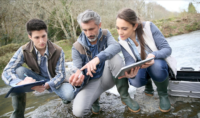By exploring the basics of this topic, students will build an understanding of the molecules that make up the world around them. In this article, we will provide you with the basics on the topic, as well as examples of chemical change that you can share with your class.
What is a Chemical Change?
A chemical change (also known as a chemical reaction) occurs when the atoms of one substance (reactants) are rearranged to form one or more different substances (products). Unlike a physical change (when the physical properties of a substance are changed), a chemical change occurs on the molecular level, produces new substances, and transforms the substance. Learning about chemical changes introduces students to basic concepts related to atoms and molecules, which they will find useful as their chemistry education continues.
Different Types of Chemical Chances
There are 5 different types of chemical changes that you should explore with students and demonstrate for a holistic understanding of this topic.
- Synthesis reactions– Two or more reactants combine to make 1 new product.
- Decomposition reactions– A single reactant breaks down to form 2 or more products.
- Single-replacement reactions– A single element replaces a similar element or an adjacent reactant compound.
- Double-replacement reactions–Two ionic compounds exchange ions, producing 2 new ionic compounds.
- Combustion reactions-A single element or compound combines with oxygen releasing energy.
Carolina Chemonstrations: Reaction Types Kit includes all the materials you need to demonstrate all five reactions types to your students.
Examples of Chemical Change
Studying examples of chemical change will help your class conceptualize this topic. Examples of chemical changes include baking soda and vinegar creating carbon dioxide, iron rusting, and wood burning. The body creates a variety of chemical reactions as well, including the metabolization of food and the combination of sugar and saliva creating amylase. Cooking also provides great examples of “real world” chemical changes. From eggs frying to cakes baking, the kitchen is a great place to explore chemical reactions with even the youngest students.
Experiments to Try
There are a variety of experiments that you can conduct with your students to introduce them to chemical changes. Simple experiments like burning wood or frying an egg can teach kids about chemistry in a matter of minutes. Carolina also offers a variety of science kits on this topic for in-depth learning. These kits include the materials needed for your experiment as well as all instructor resources. Your students can explore mystery chemical reactions, discover acids and bases, learn about thermochemistry and more.
Whether you’re looking for science experiment kits, teaching guides, or general science education resources, Carolina has materials for you. Our comprehensive website has everything you need to explore chemical changes with your students, as well as everything you’ll need to continue their chemistry learning.




